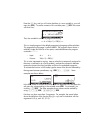
Page 4-3
Notice that the last entry shows a complex number in the form x+iy. This is so
because the number was entered between single quotes, which represents an
algebraic expression. To evaluate this number use the EVAL key( μ).
Once the algebraic expression is evaluated, you recover the complex number
(3.5,1.2).
Polar representation of a complex number
The result shown above represents a Cartesian (rectangular) representation of
the complex number 3.5-1.2i. A polar representation is possible if we change
the coordinate system to cylindrical or polar, by using function CYLIN. You can
find this function in the catalog (‚N). Changing to polar shows the result!
in RPN mode:
For this result, it is in standard notation and the angular measure is set to
radians (you can always change to radians by using function RAD). The result
shown above represents a magnitude, 3.7, and an angle 0.33029…. The
angle symbol (
∠) is shown in front of the angle measure.
Return to Cartesian or rectangular coordinates by using function RECT
(available in the catalog, ‚N). A complex number in polar
representation is written as z = r
⋅e
iθ
. You can enter this complex number into
the calculator by using an ordered pair of the form (r,
∠θ). The angle symbol
(
∠) can be entered as ~‚6. For example, the complex number z =
5.2e
1.5i
, can be entered as follows (the figures show the stack, before and after
entering the number):
Because the coordinate system is set to rectangular (or Cartesian), the
calculator automatically converts the number entered to Cartesian coordinates,
i.e., x = r cos
θ, y = r sin θ, resulting, for this case, in (0.3678…, 5.18…).


















